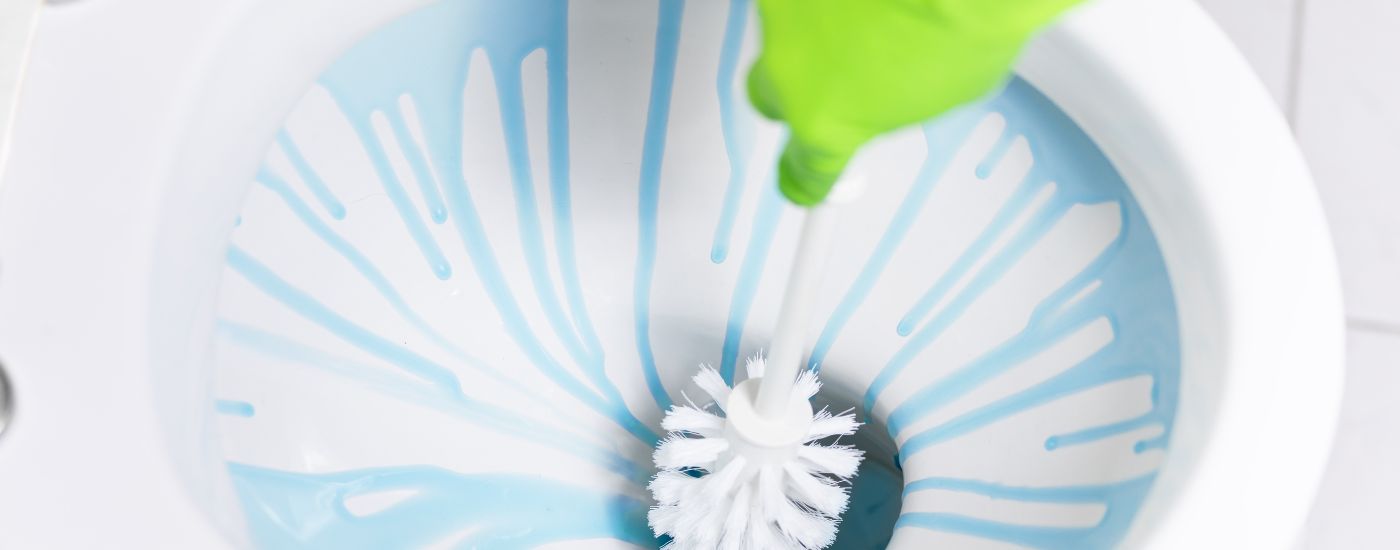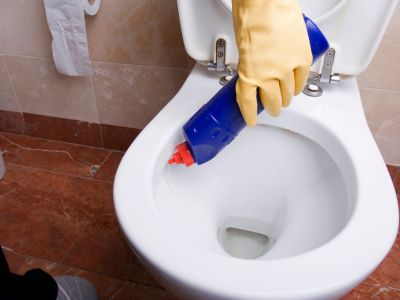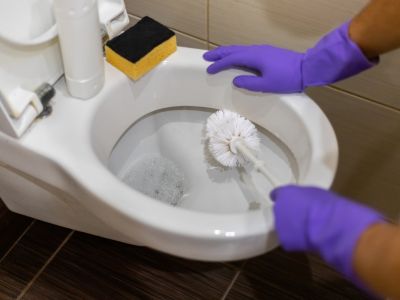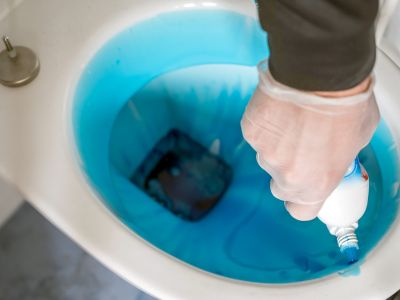How to Clean Your Toilet Like a Pro: Tips, Techniques, and Extra Tricks for a Sparkling Throne
 Stephanie Cooper
Stephanie Cooper
Cleaning the toilet is hardly anyone's favourite household chore. However, with the right approach, tools, and mindset, you can transform this mundane task into something that's not only quick and effective but, dare we say, satisfying. Armed with professional techniques and additional tips, we will show you how to banish stains, defeat germs, and leave your bathroom smelling fresh and looking spotless. So, let's roll up our sleeves and start turning your toilet into a pristine sanctuary.
Mastering the Basics: The Right Supplies

Before diving into the nitty-gritty, gathering the right supplies is essential. Your cleaning arsenal should include:
White vinegar - A powerful, natural cleaner that's excellent for breaking down mineral deposits and disinfecting.
Baking soda - Acts as a gentle abrasive to scrub away stains without damaging the porcelain.
Pumice stone - Ideal for tackling stubborn stains like hard water marks or limescale.
Rubber gloves - Protect your hands from both germs and harsh cleaning agents.
Toilet brush - A sturdy, bristled brush is your go-to for scrubbing, but consider having a separate one for more delicate tasks.
Toilet cleaner - Whether a natural product or a stronger chemical cleaner, ensure it suits your needs.
Conquering Hard Water Stains: A Step-by-Step Guide
Hard water stains are a common issue, leaving unsightly rings and deposits in your toilet bowl. These mineral deposits can be stubborn, but with the following steps, you can make them a thing of the past:
Lower the Water Level - Start by flushing the toilet to lower the water level in the bowl. For stains above the waterline, turn off the water supply and flush again to empty the bowl completely.
Apply White Vinegar—Pour white vinegar directly onto the stained areas and let it sit for 30 minutes to an hour. The vinegar works by breaking down the minerals causing the stains.
Scrub with a Toilet Brush - After the vinegar has had time to work, scrub the stains using a toilet brush. For extra cleaning power, dip the brush in vinegar before scrubbing.
Use Baking Soda for Stubborn Stains - If some stains are still clinging on, sprinkle baking soda over them and let them sit for 10 minutes. Baking soda's mild abrasiveness can help lift these lingering marks.
Scrub Again and Flush - Give the bowl another good scrub, focusing on the areas with baking soda. Finally, flush the toilet to rinse away the residue.
Tackle Stubborn Stains with a Pumice Stone - Gently rub a wet pumice stone over them for persistent stains. Apply light pressure to avoid scratching the porcelain. Repeat the process if necessary.
Prevent Future Stains - The key to maintaining a stain-free toilet is prevention. To prevent mineral buildup, use a toilet cleaner designed for hard water at least once a week.
Banishing the Dreaded Toilet Ring

Toilet rings are another common and frustrating problem, often caused by hard water and organic material buildup. Here's how to get rid of them:
Vinegar and Baking Soda Method - Like tackling hard water stains, pour white vinegar over the toilet ring and let it sit for about 30 minutes. Sprinkle baking soda over the ring and scrub with a toilet brush before flushing.
Lemon Juice and Borax - For a natural alternative, squeeze fresh lemon juice over the ring, then sprinkle Borax powder. Let this mixture sit for a few hours. Scrub with a brush, then flush to reveal a ring-free bowl.
Pumice Stone Approach - A pumice stone is your last resort for rings that resist vinegar and lemon juice. Wet the stone and gently rub it over the ring, careful not to scratch the porcelain. After scrubbing, flush the toilet to rinse away the remnants.
Battling Limescale: A Tougher Challenge
Limescale is one of the most challenging issues in your toilet, especially in areas with very hard water. It is a hard, chalky deposit made primarily of calcium carbonate, and it can be a nightmare to remove if not addressed early.
Vinegar and Baking Soda Combo: As with other stains, vinegar and baking soda are your best friends. For limescale, however, patience is crucial. Pour a generous amount of vinegar into the bowl and let it soak for several hours or overnight to dissolve the deposits.
Citric Acid Solution: Another effective method involves using citric acid, which you can find in powder or liquid form. Follow the instructions for dilution, then pour the solution into the toilet bowl, ensuring it covers all the limescale. Let it sit for several hours, then scrub thoroughly and flush.
Pumice Stone for Stubborn Deposits: If the limescale persists, use a pumice stone as a last resort. Wet the stone and gently scrub the limescale. Apply minimal pressure to avoid damaging the porcelain.
How Often Should You Clean Your Toilet?

Keeping your toilet clean isn't just about aesthetics; it's also about hygiene. Toilets can harbour bacteria, viruses, and other pathogens, so regular cleaning is essential.
Daily or Every Other Day: A quick wipe-down with a disinfecting wipe or a spray of cleaner and a brush around the bowl will prevent grime and stains from setting in.
Weekly Deep Cleaning: A thorough cleaning should be done at least once a week. It includes scrubbing the bowl, cleaning under the rim, and disinfecting the handle, seat, and other high-touch areas.
Post-Illness Disinfection: If someone in your household has been ill, it's wise to disinfect the toilet every 2-3 days to prevent the spread of germs.
Don't Forget Your Cleaning Tools
Your toilet isn't the only thing that needs cleaning; your tools do, too. After all, a dirty brush or sponge can harbour bacteria and spread it around rather than clean it.
Disinfect Your Toilet Brush: After each use, rinse the brush with hot water and spray it with a disinfectant. Place it in a holder that keeps the bristles elevated to air-dry.
Clean and Disinfect Gloves and Sponges: Soak your gloves, sponges, and other reusable cleaning tools in a bleach solution (3 tablespoons bleach to 1 quart of water) for five minutes. After soaking, rinse them thoroughly and let them air dry.
Dos and Don'ts of Toilet Cleaner Use
It is crucial to use toilet cleaners effectively and safely. Misuse can lead to wasted effort, damaged plumbing, or health risks.
Do's:
Read the Label: Always follow the instructions on the cleaner's label. It ensures you're using the right amount and leaving it on for the correct time.
Choose Eco-Friendly Cleaners—For your health and the environment, consider using gentler natural cleaners. Many plant-based products work just as effectively as traditional ones.
Ventilate the Bathroom: Open windows or turn on an exhaust fan while cleaning to avoid inhaling strong fumes.
Let the Cleaner Work: Apply the cleaner and give it time to break down grime and kill germs. This "contact time" is often listed on the product label.
Scrub Smart: Use a toilet brush with firm but flexible bristles. Long-handled brushes or disposable pads can help reach difficult areas.
Don'ts:
Mix Cleaners: Never mix different cleaning products, especially bleach, with ammonia, as this can create toxic fumes.
Overuse Cleaners: Using too much cleaner is wasteful and can damage your toilet or plumbing over time.
Flush Too Soon: To ensure the cleaner has done its job, allow it to sit for the recommended time before flushing.
Use Abrasive Tools: Avoid using steel wool or other abrasive materials, which can scratch the toilet's surface and make it more prone to staining.
Going Green: The Power of Natural Cleaning
Natural cleaners offer a safer, eco-friendly alternative to traditional chemical-based products. Here's why you should consider making the switch:
Healthier for You: Natural cleaners are free from harsh chemicals that can irritate your skin, eyes, or respiratory system.
Environmentally Friendly: These products are biodegradable and usually come in recyclable packaging, reducing your environmental footprint.
Effective Cleaning: Don't underestimate the power of natural ingredients like vinegar, baking soda, and essential oils, which can disinfect and clean just as well as their chemical counterparts.
Pleasant Scents: Many natural cleaners contain essential oils, leaving a fresh, pleasant fragrance instead of harsh chemical odours.
Conclusion: Your Path to a Pristine Toilet
Cleaning your toilet doesn't have to be a dreaded task. Following these tips and techniques, you can keep your bathroom spotless, safe, and pleasant-smelling. With the right tools, regular maintenance, and a bit of elbow grease, your porcelain throne will remain a sparkling sanctuary. Remember, whether you choose natural cleaners or more traditional products, it's all about the correct technique and consistency. Now, grab your supplies and get ready to conquer the porcelain kingdom!
Subscribe to my newsletter
Read articles from Stephanie Cooper directly inside your inbox. Subscribe to the newsletter, and don't miss out.
Written by
